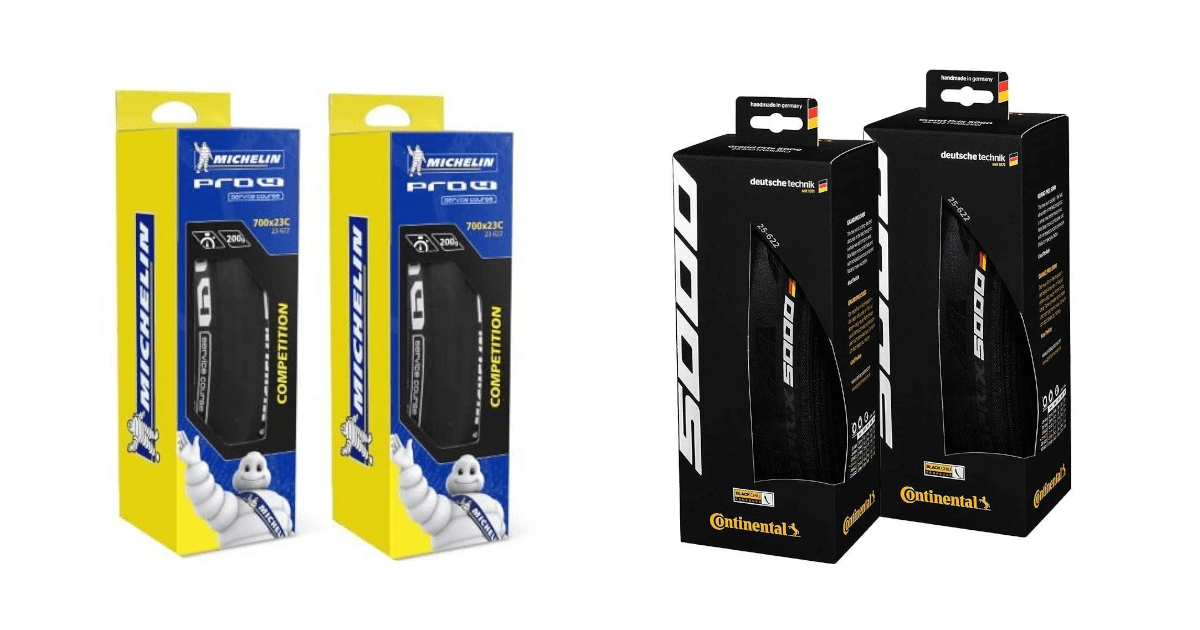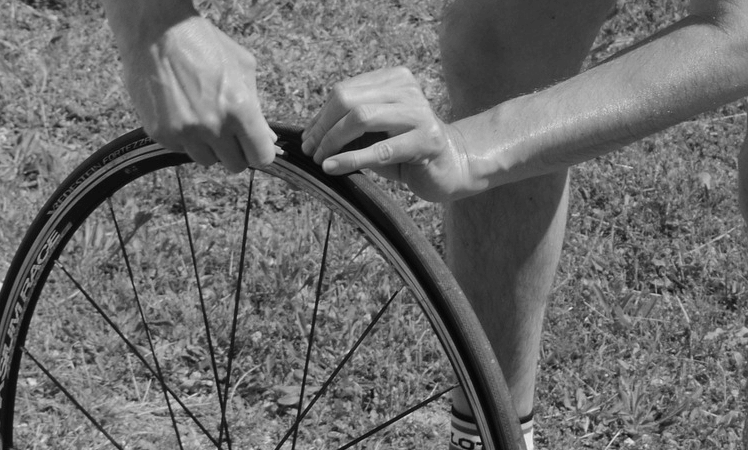Overview and Specifications of WheelTop's Affordable Electronic Groupset "EDS"
This article summarizes the features and specifications of the budget-friendly electronic groupset "EDS" newly released by the Chinese manufacturer WheelTop.
Modified at: Jun 13, 2022
Posted at: Nov 19, 2021
Clincher tires are widely used on bicycles, from city bikes to road bikes and other sports bikes. The following is a summary of their advantages and disadvantages.

Table of contents
Sponsored Link
The biggest advantage of clincher tires is their ease of maintenance.
If you have never changed a tire tube before, you may be worried, but once you try it, it is not that difficult a task, and once you learn it, clincher tire maintenance is so easy that anyone can change it in a few minutes.

This is an advantage of clinchers over tubulars, which are difficult to remove and install, tubeless-ready tires that require sealant, and tubeless tires that require a tire booster to inflate at once.
It also has the advantage of being lightweight, as you only need to bring a replacement tube and an inflator with you when you have trouble on long rides such as cycling.
Since clincher tires are the most common type of tire used on bicycles today, they offer the widest choice, not only for city bikes, but also for road bikes and hybrid bikes.
Furthermore, most wheels on complete bicycles are clincher holes or tubeless-ready wheels that can also be used with clinchers, so there is the advantage of being able to try a variety of tires without having to change wheels.
In this respect, they are easier than tubular or tubeless-ready tires, which require specialized wheels.
Clincher tires are less expensive than tubular or tubeless tires because of their simpler construction due to the separation of the tube and tire.
In addition, there are many entry-level tires in the clincher tire lineup that cost between $20 and $30 per tire, so the lower price of clincher tires is sometimes an advantage in cases where cost performance is more important than performance, such as commuting to work or school.
Since the tube, a perforation-prone part, is in contact with the wheel rim, low air pressure can easily cause a “rim-striking puncture,” a puncture in the tube caused by being caught between the rim and the tire.
Also, since clincher tires are held in shape by the tube, if a foreign object that is stepped on penetrates the tire and reaches the tube, the tire will lose air and become un-rideable.
In addition to these external factors, punctures can also occur due to deterioration of the tube, since the tire and tube are constantly rubbing against each other.
In this area, tubular tires, which are more resistant to punctures, and tubeless-ready tires, which have holes that can be filled with sealant, are the best choice.
Clincher tires require a tube because they cannot be used without an inner tube. Even a lightweight tire tube weighs about 100g each, so the tube itself is inevitably heavier than the inner tube.
Compared to tubular tires, clincher tires are lightweight even with tubes, but they are inevitably heavier than the latest tubeless tires.
Looking at new releases from tire manufacturers, tubeless-ready and tubeless tires are gradually spreading among tires that used to be either clinchers or tubulars. Some manufacturers even say that their new products are only tubeless tires.
This is especially true in the sports bicycle industry, so there is a possibility that the number of new clincher tires will gradually decrease in the future.
However, there are still quite a few existing users of clincher tires, so it is safe to assume that there will be a solid product lineup for the next 10 years or so.
Sponsored Link
Choosing the right tires for a rainy road bike ride
Road bikes are often used for riding in the rain. In this article, we summarize tire selection for riding in the rain on a road bike.
Tire Tubes: Types, Manufacturers, and Selection Tips
Tire tubes are consumable parts that are replaced relatively frequently on bicycles. We have compiled a list of tire tube types, manufacturers, and points to keep in mind when selecting a tire tube.
Properly Inflating Bicycle Tires: The Importance
Tire air maintenance is surprisingly often neglected, but in fact, it is only beneficial. In this issue, we summarize the importance of keeping tires well inflated and the precautions to take when inflating tires.
Road Bike Tires: Types and How to Enjoy Them
Changing tires can change the way you ride! We have compiled a list of different types of tires for road bikes, their respective characteristics, advantages and disadvantages, and how changing tires can make road biking more enjoyable.
Changing Bicycle Tire Size and Thickness: 3 Key Points
Tire customization is a fun way to change the riding experience for a cost of about $100. When replacing tires, there are three points to keep in mind when changing the size and thickness of your bicycle tires.
Bicycle Tire Lifespan: Tips to Extend and Check for Wear
This section summarizes the life of a typical bicycle tire, how to check for wear and tear, and how to replace a tire. Also how to store tires to extend their life.
Road Bike Tire Names, Sizes, and Standards
There are many different types of tires for road bikes, including different size standards and types. In this issue, we summarize the key points you should know about road bike tires.
Advantages and disadvantages of clincher tires
Clincher tires are widely used on bicycles, from city bikes to road bikes and other sports bikes. The following is a summary of their advantages and disadvantages.
Advantages and disadvantages of tubular tires
Tubular tires are the choice of users who are concerned about performance. In this issue, we summarize the advantages and disadvantages of tubular tires and what kind of users they match.
Tubeless and Tubeless Ready Tires: Pros and Cons
Tubeless and tubeless ready tires are increasingly being adopted in the latest wheels. The following is a summary of the differences, advantages and disadvantages of each, and points to keep in mind when choosing.
TPU Inner Tube: Features, Pros, and Cons for Road Bikes and MTB
TPU inner tubes are gaining attention as the third force in bicycle tires. We summarize its features, advantages and disadvantages of using it on Road bikes and MTBs, and major manufacturers.
Overview and Specifications of WheelTop's Affordable Electronic Groupset "EDS"
This article summarizes the features and specifications of the budget-friendly electronic groupset "EDS" newly released by the Chinese manufacturer WheelTop.
What Is Shimano Shadow RD? Features and Benefits
What is Shimano’s Shadow RD used in their latest rear derailleurs? This article explains its features and the benefits of choosing Shadow RD.
[MTB / Hybrid Bike] Hydraulic Brake Manufacturers for Flat Bars
An overview of manufacturers that produce hydraulic brakes for flat-bar MTB and hybrid bikes, along with their key features. Also includes tips on how to choose the right flat-bar hydraulic brake brand.
Shimano Chain Compatibility for Road, MTB, and Hybrid Bikes
An overview of Shimano chain compatibility across road bikes, mountain bikes, and hybrid bikes. Includes guidance on how to choose the right chain for your drivetrain.
Shimano ESSA Lineup and Compatibility with Existing 8-Speed Parts
An overview of Shimano's newly released 8-speed component group "ESSA" and its compatibility with existing 8-speed parts.
SRAM Cassette Compatibility Guide
Compatibility guide for SRAM cassettes used in road and MTB bikes. Find matching drivetrains and wheels easily.
Compatibility Guide for SRAM MTB Components
A detailed explanation of compatibility between SRAM MTB components. This guide outlines which parts can be used together and which combinations are not compatible.
Road and MTB Sprockets Compatibility Overview
A guide to the compatibility between road and MTB sprockets, explaining whether they can be used together with different components.
Types of Shimano Di2 Tools and Their Compatibility
A guide to the essential Shimano Di2-specific tools, especially the "plug tools" used for connecting components, and their compatibility with various Di2 parts.
Shimano CUES Cassette Compatibility Guide
A detailed guide to the compatibility of Shimano CUES series cassettes. Includes an overview of compatible rear derailleurs, chains, and wheels.
Shimano Hydraulic Brake Hose and Connector Standards Guide
An explanation of the differences between Shimano’s hydraulic brake hoses BH90 and BH59, the types of connecting bolts, and how to choose the right hose for your brake system—including key points to watch out for.
[By Manufacturer] Types, Features, Pros and Cons of Hydraulic Brake Oils
This article explains the types of hydraulic oils used in bicycle hydraulic brakes, their characteristics, and the brake oil types used by each manufacturer.
Types and Compatibility of Shimano Di2 Batteries
The Di2 battery is the core of the Shimano Di2 system, influencing the overall system layout. This article explains the different types and their compatibility.
Shimano Di2 Wire Types and Compatibility
Overview of Shimano Di2 electric wire types and their compatibility with Di2 components.
How to Identify Shimano Di2 Generations
Explains the generational differences in Shimano Di2 components and their compatibility. Includes a list of component series and their corresponding generations.
In-Depth Guide to Shimano 12-Speed Cassette Compatibility
A detailed explanation of the key compatibility factors when using Shimano's 12-speed cassettes—specifically the required wheel (freehub) and drivetrain, which differ significantly from previous 11-speed systems.
Perfect Guide to Shimano 11-Speed Cassette Compatibility
A detailed explanation of two key compatibility factors when using Shimano 11-speed cassettes: the required wheel (freehub) and drivetrain.
Perfect Guide to Shimano 10-Speed Cassette Compatibility
A detailed explanation of two key compatibility factors when using Shimano 10-speed cassettes: the required wheel (freehub) and drivetrain.
In-Depth Guide to Shimano 9-Speed Cassette Compatibility
A comprehensive explanation of two key compatibility factors when using Shimano 9-speed cassettes: the required wheel (freehub) and drivetrain.
What Is a BOOST Crank? Differences from Standard MTB Cranks and How to Choose
This article explains what a BOOST crank is, how it differs from conventional MTB cranks, and provides guidance on selection across different manufacturers.